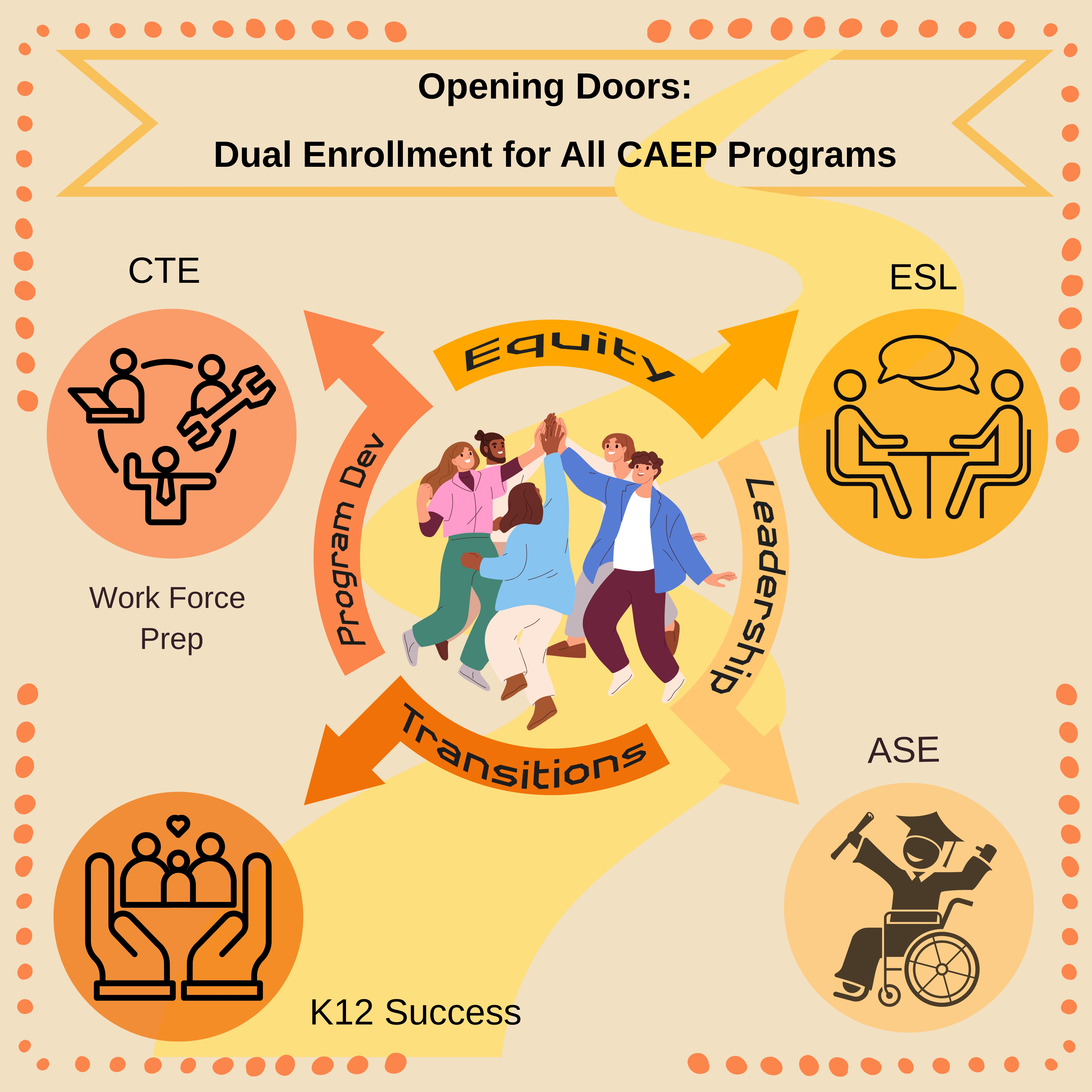Opening Doors: Dual Enrollment for All CAEP Students (Beyond HSD/HSE)
Submitted By: Jenée Crayne
Foothill De Anza / NSCCSTC
Website: https://www.nscadulted.com
Type of Practice: Learner Transition
Program Area(s): ABE / ASE, ESL / EL Civics / Citizenship, CTE / Workforce Prep / Pre-apprenticeship, Adults with Disabilities, K12 Success
Region: Bay Area
Consortia Involved: Foothill De Anza / NSCCSTC
The Program of Practice
Limiting dual enrollment to only HSD/HSE programs prevents many CAEP students from participating in this accessible and equitable entry point into college. Why? First, not all adult schools have HSD/HSE programs (one of NSCCC’s does not). Second, most adult school CAEP students are ELL learners, and the majority are not enrolled in HSD/HSE programs. Third, students in CTE pathways also miss out on this equitable opportunity to advance their career goals through college programs.
The Response
What: NSCCC expanded dual enrollment (SB 554) to adult school students in ALL CAEP funded programs (beyond the HSD/HSE connection). NSCCC continues to enhance how students succeed in dual enrollment courses by utilizing lessons learned to improve our best practices for student support.
Why: Dual Enrollment is an equitable & accessible opportunity for adult school students to enter college; therefore, removing programmatic barriers and making dual enrollment accessible to all adult school CAEP students helps support the State Priorities of: Equity, Leadership, Learner Transition, and Program Development.
Who: Adult School CAEP students in any CAEP funded program are eligible, with a focus on ASE (HSD/HSE), high-level ESL, CTE, and K-12 Success students to ensure college success.
When: College District policy change work began in 2017; the college board approved in 2020. Since the 2021-22 academic year, we have focused on improving student supports across the consortium to help students access and succeed in dual enrollment opportunities.
How:
Implementing the new college district policy for dual enrollment evolved through strong leadership, collaboration, and policy refinement.
Dual Enrollment in Action– Student Success: Students follow a structured enrollment process supported by adult schools and college team members. Common Barriers include misaligned processes between colleges, registration challenges, and data tracking inefficiencies. Growth Opportunities include enhancing transition support, aligning schedules, improving data tracking, and fostering student advocacy. Best Practices include: Regular meetings and shared resources across transition teams and adult schools to ensure seamless collaboration. Targeted outreach efforts, including information sessions, application workshops, and dual enrollment promotional materials.
The Unique Features of the Program
The program is unique because its college district leveraged existing ed codes and legislation to change their policy and broaden dual enrollment eligibility beyond HSD/HSE status, making dual enrollment accessible to more CAEP adult school students.
The program is also unique for these four reasons: 1. students have the opportunity to take any course that aligns with their education goals. 2. In targeted pathways courses, seats are saved for adult school students. 3. De Anza offered a counseling course that is exclusive to adult school students. 4. Students are supported along the way by adult school and college transition team members.
This offers a model for other consortia to follow and creates a positive affect for CAEP students and consortia across the adult education field.
The Outcome
Expanded dual enrollment promotes smoother transitions to college for more CAEP adult school students and strengthens institutional partnerships, enhancing inclusion and opportunity. This can be seen in the idata: the increase of the number of individual students (unduplicated) taking a dual enrollment course, and the increase in the number of courses these students take per year (duplicated).
2021-22
Unduplicated: 53 students participate in dual enrollment
Duplicated: 85 dual enrollment courses were taken
2022-23
Unduplicated: 56 students participate in dual enrollment
Duplicated: 108 dual enrollment courses were taken
2023-24
Unduplicated: 93 students participate in dual enrollment
Duplicated: 169 dual enrollment courses were taken
2024-25
Unduplicated: 98 students participate in dual enrollment
Duplicated: 238 dual enrollment courses were taken

